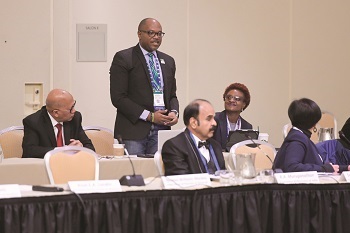New Mexico physicians care for migrants
New Mexico's department of health and physician volunteers are managing the medical needs of families with children crossing its border with Mexico, as well as recent immigrants from other states transported there by federal officials.
When a group of asylum seekers arrived in Albuquerque from Texas last summer, ACP Member Krystal Chan, MD, noticed that the parents stayed very close to their children during medical screenings, sometimes keeping even older children in their laps.
Many of the parents and children appeared to have been recently reunited, said Dr. Chan, then a co-chief resident at the University of New Mexico (UNM) Health Sciences Center and now an assistant professor there in the department of internal medicine.

Her time with the patients allowed only a cursory screening to look for any pressing medical issues and some diseases, such as tuberculosis. Reports of headache were common, likely related to dehydration, as were signs of emotional strain in some of the parents, she said.
“Anxiety and likely post-traumatic stress disorder,” Dr. Chan said. “And there's just not enough time to build rapport to be able to dig deep into those issues.”
While Texas has frequently made the news recently for its border health crisis, its next-door neighbor New Mexico has also seen an increase in families with children crossing its border with Mexico, many seeking asylum from countries in Central America. The state has also had to deal with recent immigrants transported there by federal officials from other states.
In response, New Mexico's department of health, medical schools, and physician volunteers have geared up efforts to try to address their immediate medical needs.
Travel triage
Early this spring, the state health department launched a mobile van unit to provide medical support in Las Cruces and other border regions, said Abinash Achrekar, MD, the health department's deputy cabinet secretary.
The need for triage screening of migrants is likely not going to wane any time soon, Dr. Achrekar said. As of early summer, he was particularly concerned about an influx of asylum seekers being transported by Immigration and Customs Enforcement officials to the small community of Deming, 60 miles west of Las Cruces. Given Deming's population of just 14,000 residents, and relatively isolated location, there isn't a sizable network of nearby clinicians to help out, he said.
“We are providing sometimes their first medical screening,” Dr. Achrekar said. “If it's not their first medical screening, we're still seeing a significant amount of dehydration when they're dropped off in Deming. So there's definitely a need for more medical evaluation and treatment.”
John Andazola, MD, a family medicine physician in Las Cruces, has been assisting with screening of migrants for years. But last fall the numbers of new arrivals started to ratchet upward, from about 200 each week last September to close to 200 a day by March and April, sometimes as many as 2,000 a week, said Dr. Andazola, who is also program director for the Southern New Mexico Family Medicine Residency Program in Las Cruces.
It's not uncommon for people to remain in Las Cruces for just four to six hours before traveling to their sponsor families, said Dr. Andazola, who described the role that he and other clinician volunteers play as a form of travel triage. “If someone comes into my community, I want to make sure they are well enough to get to their final destination,” he said.
By May, the numbers of incoming migrants had become so great that the city opened up an old former U.S. Army Reserve training center for temporary housing. (A May 9 article in the Las Cruces Sun News said that the U.S. Border Patrol had released 4,200 asylum seekers in Las Cruces since April 12.)
Physicians, trainees, and other clinicians circulate among each group of new arrivals, asking if anyone needs to see a doctor, Dr. Andazola said. “And we also try to pick out anybody who looks like they need help,” he said. He estimated that for every 200 people, typically 15 to 30 need medical screening or treatment.
Dr. Andazola also has invested time in education and addressing any community concerns. “There is a lot of fear that exists that these people are harboring communicable diseases and potentially putting our populace at risk,” he said. “The fact of the matter is that they do not have communicable diseases.” For example, as of late spring, he couldn't recall more than two cases of potentially active tuberculosis that he had diagnosed since September 2018.
Dr. Achrekar made a similar point in a guest editorial published March 26, 2019, in the Albuquerque Journal, writing that immunization rates in people's home countries are comparable to those in New Mexico and the United States and that cases “of communicable diseases are very rare.”
More serious concerns
Based on his work in Las Cruces, Dr. Andazola estimated that just 1% to 2% of migrants have been sick enough to be admitted to the hospital, typically children, with seasonal patterns such as more flu-related admissions during influenza's peak earlier this year.
When Dr. Chan was volunteering last summer, she recalled a patient with diabetes who had been given insulin at a prior stop but had no way to refrigerate it. He had developed worrisomely high blood glucose levels, she said. “I wanted to make sure there weren't any complications from that, so we sent him over to the urgent care.” That patient, she said, got a cooler for his insulin before leaving Albuquerque.
Dr. Chan also made sure that another patient was seen by a psychiatrist, as his demeanor stood out. “I think it was the lack of concern for his child,” she said. While other parents, most of them single parents, were visibly buoyed by having been reunited with their children, this father seemed to scarcely interact with his own child, she said.
Lilia Pedrego, MD, a hospitalist who volunteered periodically with a medical team in Albuquerque until this spring, recalled one patient who came in with an asthma exacerbation, likely related to the conditions of being held in a detention area under a bridge. “We had to decide—do we take him to the ER or do we treat him here?” said Dr. Pedrego, who practices at UNM Sandoval Regional Medical Center in Rio Rancho.
The medical team decided to try prednisone first and take the patient to an ED if his symptoms didn't improve, Dr. Pedrego said. But the medication worked, so the trip was not needed.
Boosting border expertise
With an eye toward the future, the New Mexico health department has joined forces with the UNM Health Sciences Center and its three associated family medicine residency programs, all forming the New Mexico Primary Care Training Consortium, to create a border health residency elective.
“If migration is not going to decrease, and we don't see an end to this,” Dr. Achrekar said, “we need to ramp up our providers that are trained to take care of asylum seekers at the border, are interested, and may want to have a career in border medicine.”
The one-month elective, which began on a pilot basis in July, will likely enroll five to six family medicine residents in the first year, said Arthur Kaufman, MD, vice chancellor for community health services at UNM Health Sciences Center.
The goal is to expand to two residents monthly by the second year, with plans to open up the elective option at some point to not just other physician resident specialties at UNM, but potentially other clinician trainees, such as nurse practitioners and physician assistants, Dr. Kaufman said. “This border crisis is not ending any time soon,” he said.
The residency program in Las Cruces (which Dr. Andazola directs) has developed the border health curriculum and will supervise the residents during the elective. The state health department is providing nearly all of the funding, paying the consortium for administration and setup as well as committing to paying the residents' salaries after the pilot year, Dr. Kaufman said.
The health department also reached out to the New Mexico Medical Board this spring to see if processing of licenses could be expedited for out-of-state physicians who want to volunteer, said Sondra Frank, JD, the board's executive director. The board agreed to waive the $600 licensing fee and substantially reduce the time involved for processing, which is typically close to two months, she said.
The goal is for physicians in good standing to get licensed within 10 business days, Ms. Frank said, stressing that there is physician interest. “There is a ton of physicians calling us who want to help, who want to know how they can help,” she said.
For Dr. Chan, the volunteer experience reminded her why she pursued medicine in the first place: to help vulnerable individuals. Moreover, despite their understandable signs of strain after a long journey, she was moved by the spirit and resilience that so many patients exhibited.
“Just seeing them and only catching a glimpse of what they may have gone through,” she said. “And for them to still have so much hope and so much optimism was very, very humbling.”





